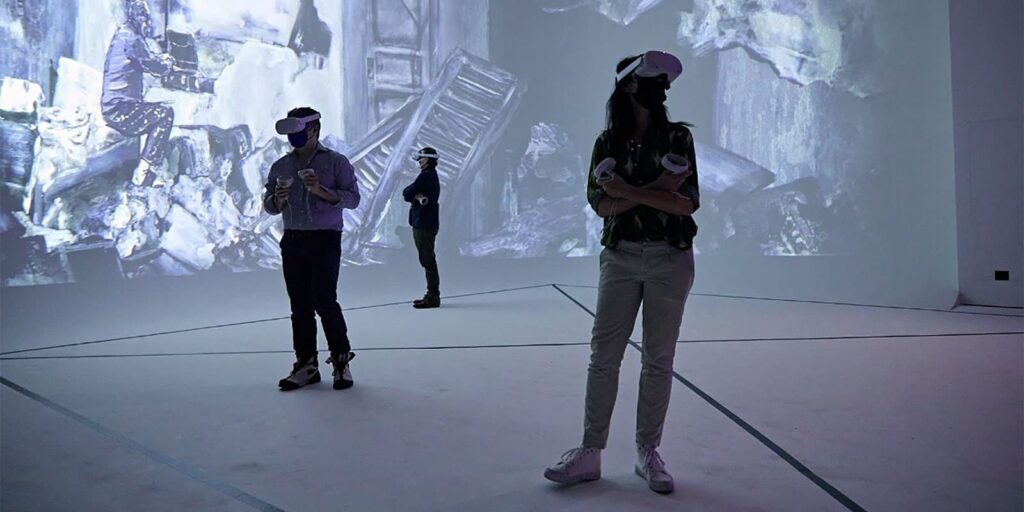In recent years, audio-visual installations have revolutionized modern art galleries, transforming static displays into dynamic, immersive experiences. These installations, which integrate sound, light, and digital technology, offer a new dimension to art appreciation, engaging multiple senses and creating a more impactful visitor experience. This article explores the significant impact of audio-visual installations in modern art galleries, highlighting their role in enhancing engagement, accessibility, and artistic expression.

Enhancing Visitor Engagement with Audio Visual Installations
Audio-visual installations have redefined the way visitors interact with art. By incorporating sound, light, and motion, these installations create an immersive environment that captivates audiences. Traditional art forms, such as paintings and sculptures, often require passive observation. In contrast, audio-visual installations invite active participation, encouraging visitors to move around and experience the artwork from different perspectives.
For instance, the use of surround sound in an installation can immerse the audience in a sonic landscape that complements the visual elements. This multisensory approach not only deepens emotional connections with the artwork but also makes the experience more memorable.
Improving Accessibility in Art Galleries
One of the most significant impacts of audio-visual installations is their ability to improve accessibility in art galleries. Traditional art displays can be challenging for individuals with visual or auditory impairments. Audio-visual installations, however, can provide alternative ways to experience art. For example, tactile elements combined with audio descriptions can offer a more inclusive experience for visually impaired visitors.
Furthermore, these installations can utilize subtitles, sign language, and other visual aids to make the art more accessible to those with hearing impairments. By catering to a broader audience, modern art galleries can foster inclusivity and ensure that art is accessible to everyone.
Expanding Artistic Expression Through Technology
Integrating audio-visual elements in art installations has opened new avenues for artistic expression. Artists are no longer limited to traditional mediums; they can now experiment with digital technology, soundscapes, and interactive components. This fusion of technology and art allows for creation of dynamic pieces that evolve or respond to viewer interaction.
For example, interactive installations that change based on audience movement or input can create a unique experience for each visitor. This highlights the audience’s importance in the creative process as well as the artist’s variety.
Case Studies: Successful Audio-Visual Installations
Several modern art galleries have successfully incorporated audio-visual installations to enhance their exhibits. One notable example is the “Rain Room” by Random International, exhibited at the Los Angeles County Museum of Art (LACMA). This installation uses motion sensors to detect visitors’ movements, allowing them to walk through a simulated rainstorm without getting wet. The combination of visual and sensory elements creates a powerful, immersive experience that has captivated audiences worldwide.
Another example is teamLab Borderless in Tokyo, an interactive digital art museum where visitors can explore rooms filled with projections, lights, and sounds that respond to their presence. This museum exemplifies how audio-visual installations can transform art spaces into interactive, ever-changing environments.
The Future of Audio Visual Installations in Art Galleries
The future of audio-visual installations in modern art galleries looks promising. As technology continues to advance, artists and curators will have even more tools at their disposal to create engaging, accessible, and innovative exhibits. Virtual reality (VR) and augmented reality (AR) are likely to play a significant role, offering new ways for visitors to experience and interact with art.
Moreover, the increasing availability of affordable technology means that more galleries, regardless of size or budget, can incorporate audio-visual elements into their exhibits. This democratization of technology will likely lead to a surge in creative, immersive art experiences that appeal to diverse audiences. Read More: The Power of Audio Visual: Enhancing Communication and Engagement
Conclusion: Embracing the Digital Evolution
In conclusion, the impact of audio-visual installations in modern art galleries is profound, enhancing visitor engagement, improving accessibility, and expanding the possibilities for artistic expression. As galleries continue to embrace digital evolution, these installations will play a crucial role in shaping the future of art appreciation and exhibition. By leveraging technology, modern art galleries can create more inclusive, dynamic, and memorable experiences for all visitors.